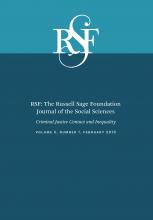Research Article
Open Access
A Debt of Care: Commercial Bail and the Gendered Logic of Criminal Justice Predation
Joshua Page, Victoria Piehowski, Joe Soss
RSF: The Russell Sage Foundation Journal of the Social Sciences February 2019, 5 (1) 150-172; DOI: https://doi.org/10.7758/RSF.2019.5.1.07
Joshua Page
aAssociate professor of sociology and law at the University of Minnesota
Victoria Piehowski
bGraduate student in the Department of Sociology at the University of Minnesota
Joe Soss
cCowles Chair for the Study of Public Service at the University of Minnesota, where he holds faculty positions in the Humphrey School of Public Affairs, Political Science, and Sociology

REFERENCES
- ↵
- Amott, Teresa, and
- Julie Matthaei
- ↵
- Bauer, Shane
- ↵
- Bianchi, Suzanne,
- Melissa Milkie,
- Liana Sayer, and
- John Robinson
- ↵
- Bourdieu, Pierre, and
- Loïc Wacquant
- Burawoy, Michael
- ↵
- Burns, Ronald, and
- Patrick Leone
- ↵
- Clear, Todd
- ↵
- Cohen, Thomas, and
- Tracey Kychelhahn
- ↵
- Cohen, Thomas, and
- Brian Reeves
- ↵
- Collins, Patricia H
- ↵
- Color of Change and ACLU
- ↵
- Comfort, Megan
- ↵
- Council of Economic Advisors
- ↵
- Crenshaw, Kimberle
- ↵
- ↵
- Dawson, Michael C
- ↵
- Demuth, Stephen
- ↵
- deVuono-powell, Saneta,
- Chris Schweidler,
- Alicia Walters, and
- Azadeh Zohrabi
- ↵
- Dill, Forrest
- ↵
- Dobbie, Will,
- Jacob Goldin, and
- Crystal Yang
- ↵
- Du Bois, W. E. B
- ↵
- Duffy, Mignon
- ↵
- Epp, Charles,
- Steven Maynard-Moody, and
- Donald Haider-Markel
- ↵
- Federici, Sylvia
- Feeley, Malcolm
- ↵
- Fineman, Martha
- ↵
- Fortunati, Leopoldina
- ↵
- Fraser, Nancy
- ↵
- Fuwa, Makiko, and
- Phillip Cohen
- ↵
- Glassman, Jim
- ↵
- Glenn, Evelyn N
- ↵
- Goffman, Erving
- ↵
- Goffman, Erving
- ↵
- Goldfarb, Ronald
- ↵
- Gordon, Linda
- ↵
- Gupta, Arpit,
- Ethan Frenchman, and
- Douglas Swanson
- ↵
- Gupta, Arpit,
- Christopher Hansman, and
- Ethan Frenchman
- ↵
- ↵
- Haley, Sarah
- ↵
- Haney, Lynne
- ↵
- Harris, Alexes
- ↵
- Harris, Alexes,
- Heather Evans, and
- Katherine Beckett
- ↵
- Hayward, Clarissa Rile
- ↵
- Hochschild, Arlie
- ↵
- Irwin, John
- ↵
- James, Doris J
- ↵
- Jerolmack, Colin, and
- Shamus Khan
- ↵
- Jones, Jacqueline
- ↵
- Justice Policy Institute
- ↵
- Kohler-Hausmann, Issa
- ↵
- LeBaron, Genevieve, and
- Adrienne Roberts
- ↵
- Lerman, Amy, and
- Vesla Weaver
- ↵
- Lichterman, Paul
- ↵
- Lopez-Aguado, Patrick
- ↵
- MacIntyre, Alasdair
- ↵
- Mauss, Marcel
- Mills, C. Wright
- Nichols, Robert
- ↵
- Noddings, Nel
- ↵
- North, Douglas
- ↵
- Pachirat, Timothy
- ↵
- Page, Joshua
- ↵
- Page, Joshua
- ↵
- Page, Joshua, and
- Joe Soss
- Pateman, Carole, and
- Charles W. Mills
- ↵
- Patillo, Mary,
- David Weiman, and
- Bruce Western
- ↵
- Phillips, Mary T
- ↵
- Rabuy, Bernadette, and
- Daniel Kopf
- ↵
- Roberts, Dorothy E
- Roberts, Dorothy E
- ↵
- Robinson, Cedric
- ↵
- Santo, Alysia
- ↵
- Schlesinger, Traci
- The Sentencing Project
- ↵
- Small, Mario Luis
- ↵
- Soss, Joe
- ↵
- Soss, Joe, and
- Vesla Weaver
- ↵
- Tilly, Charles
- ↵
- Tronto, Joan
- ↵
- Tronto, Joan
- ↵
- UCLA School of Law Criminal Justice Reform Clinic (UCLA
- ↵
- Wacquant, Loïc
- ↵
- Wakefield, Sara, and
- Christopher Wildeman
- ↵
- Walker, Michael
- Wedeen, Lisa
- ↵
- Western, Bruce
In this issue
A Debt of Care: Commercial Bail and the Gendered Logic of Criminal Justice Predation
Joshua Page, Victoria Piehowski, Joe Soss
RSF: The Russell Sage Foundation Journal of the Social Sciences Feb 2019, 5 (1) 150-172; DOI: 10.7758/RSF.2019.5.1.07
Jump to section
Related Articles
- No related articles found.
Cited By...
- No citing articles found.





